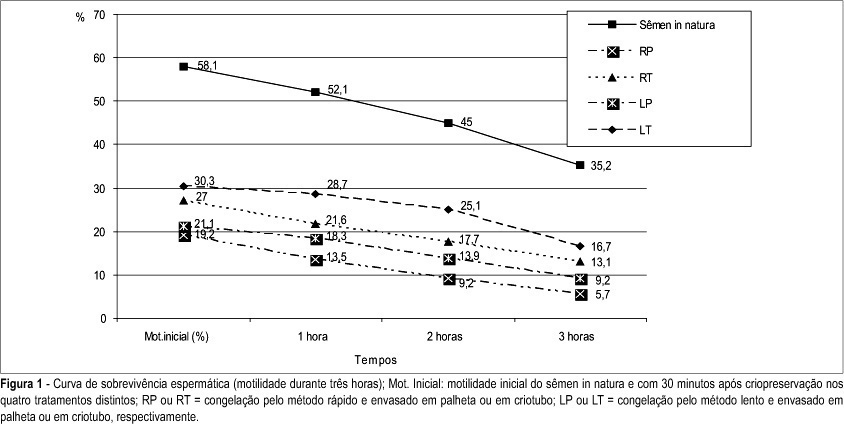Summary
Rev Bras Ginecol Obstet. 2024;46:e-rbgo36
Seminal cryopreservation causes significant damage to the sperm; therefore, different methods of cryopreservation have been studied. The aim of the study was to compare the effects of density gradient processing and washing/centrifugation with seminal plasma removal for cryopreservation in semen parameters.
Seminal samples of 26 normozoospermic patients were divided into 3 parts: with seminal plasma; after washing/centrifugation; and after selection through density gradient. The samples were cryopreserved for at least two weeks. Motility, sperm count, morphology and viability were evaluated before cryopreservation and after thawing.
Density gradient processing selected motile and viable sperm with normal morphology in fresh samples (p<0.05). Cryopreservation negatively affected all sperm parameters regardless of the processing performed, and even if the sperm recovery was lower in the density gradient after the thawing, progressive motility, total motility, viability and morphology remained higher (p<0.05).
Cryopreservation significantly compromises sperm parameters (motility, morphology, viability). In normozoospermic patients, the density gradients select better quality spermatozoa compared to other processing methods; this benefit was kept after thawing.
Summary
Rev Bras Ginecol Obstet. 2006;28(12):708-714
DOI 10.1590/S0100-72032006001200004
PURPOSE: to compare two different methods of freezing and two types of human semen storage during cryopreservation process. METHODS: experimental research in which the cryopreservation of 18 semen samples from 18 volunteers was studied. Following the addition of the cryoprotectant medium, Test-yolk buffer, the semen samples were packaged into 0.25 mL straws or into 2 mL cryotubes and submitted to cryopreservation by slow or rapid methods, in four different treatments: RS (cryopreservation by rapid method and packaged in straws), RT (rapid-cryotubes), SS (slow-straws), and ST (slow-cryotubes). Samples were thawed after 24 hand then maintained at 37ºC. Data collected were analyzed by the Student t-test, with p<0.05, using the SPSS computer program for Windows®, version 11.0.0. RESULTS: the motility of spermatozoa decreased after the cryopreservation process. The initial motility rate was 58.1% and motilities after the different methods of cryopreservation were 19.2% (RS), 27% (RT), 21.1% (SS) and 30.3% (ST). There was a significant decrease of the normal morphology. The initial normal morphology was 14.2% and morphologies after the different methods of cryopreservation were 12.8% (RS), 12.6% (RT), 12.6% (SS) and 12.4% (ST). CONCLUSIONS: the slow method of cryopreservation with storage in cryotubes showed the best recovery of motile cells after freezing and thawing. There was no difference among the methods when appraised the morphology.

Summary
Rev Bras Ginecol Obstet. 2006;28(1):44-49
DOI 10.1590/S0100-72032006000100008
PURPOSE: to evaluate the influence of abstinence period on seminal characteristics in infertile men and to establish a better seminal quality after pooling the samples. METHODS: a retrospective study was performed on 88 oligozoospermic (n=25), asthenozoospermic (n=43), and oligoasthenozoospermic (n=20) men whose partners underwent intrauterine insemination between September 2002 and December 2004. We excluded men with a normal semen analysis or women with abnormalities suggestive of infertility. Each man produced two semen samples in a short period of time (30 min to 1 h). We evaluated semen volume, total motile sperm count and percentage sperm motility. Comparisons were made between the first and second semen samples. After pooling the samples, we compared the total motile sperm count between the first sample and the pooled samples. Statistical evaluation was performed by Student's t test and the chi2 test. RESULTS: in oligozoospermic men, there were no differences in the semen characteristics between the first and the second seminal samples (p>0.05). The total motile sperm count increased significantly in the second sample in comparison to the first sample in asthenozoospermic (42.4±6.8 vs 51.5±7.2x10(6) sperm/mL) and oligoasthenozoospermic men (11.1±7.4 vs 14.35±7.2x10(6) sperm/mL (p<0.05). The pool of two ejaculates increased the total motile sperm count in comparison to the first sample (p<0.05) in oligozoospermic, asthenozoospermic and oligoasthenozoospermic men by 110.5, 110.3 and 136.03%, respectively. CONCLUSIONS: a short period of abstinence is associated with higher sperm motility in infertile men. The pool of two semen samples is a way to increase the total motile sperm count in this group of patients whose wives want to undergo an intrauterine insemination instead of in vitro fertilization.
Search
Search in:
breast (42) breast cancer (42) breast neoplasms (95) Cesarean section (72) endometriosis (66) infertility (56) Maternal mortality (43) menopause (82) obesity (58) postpartum period (40) pregnancy (225) Pregnancy complications (99) Prenatal care (68) prenatal diagnosis (50) Prevalence (41) Quality of life (51) risk factors (94) ultrasonography (79) urinary incontinence (40) women's health (48)